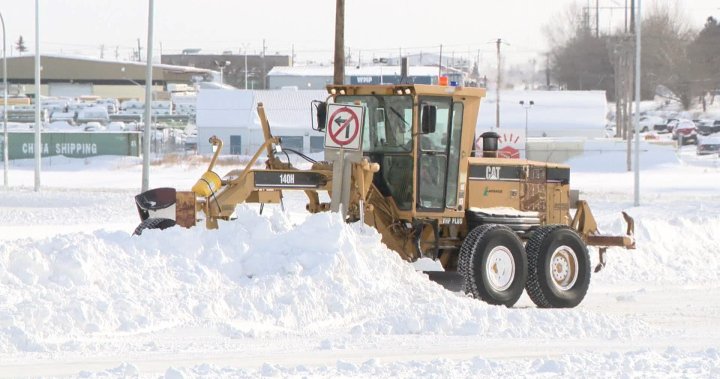On a cool Thursday afternoon in Ottawa, veteran police officer Sgt. Avery Flanagan approaches a man hunched over in a downtown parking lot. He has crushed opioids in one hand and a needle in the other.
Flanagan tells the man, who appears to be in his 20s, he can’t use drugs on private property.
“Have you ever overdosed on fentanyl?” asks the officer.
“Twice or three times,” he responds. “You hit the floor, you wake up, you don’t even know that you’ve overdosed.”
“Pretty scary feeling?” asks Flanagan.
“Yeah, pretty scary,” he answers.
Similar encounters unfolded throughout the day as Global News accompanied the officer during a patrol last November of the city’s downtown, an area where the opioid epidemic and housing crisis are colliding and having deadly consequences.
In the two months since, the Public Health Agency of Canada released updated 2023 numbers in December 2023 showcasing the staggering scope of opioid and drug overdoses across the country. That data showed an average of 22 deaths per day from apparent opioid toxicity between the first six months of last year, up five per cent from the same period in 2022.
Most of those — 89 per cent — are in three places: B.C., Alberta and Ontario.
And as housing affordability becomes a political lightning rod set to dominate the return of the House of Commons on Jan. 29, there is growing attention not just on those who struggle to make their rent or mortgage payments, but also on those who don’t have a home at all.
“The opioid crisis is something that I’ve seen really, really hurt us. And it’s been a struggle to get a hold,” said Flanagan.
The officer is a member of the Ottawa Police Service’s neighbourhood resource team, which focuses on crime prevention and public safety.
Flanagan comes from a family of police officers and has spent most of his 20-year career working in downtown Ottawa, which is undergoing a dramatic transformation, he says.
In his view, Ottawa could just as well be any Canadian city.
“I don’t think we’re unique at all,” he told Global News. “I’ve travelled through work, and I’ve travelled personally, and I’ve seen it from Victoria to Greater Halifax.”
“Even before the pandemic, North America was hit by this opioid crisis. That’s probably been the biggest change that I’ve seen,” added Flanagan.
The veteran officer says one of the biggest challenges in his 20-year career has been trying to respond to the overdose epidemic.
The most recent available data shows nearly 4,000 Canadians died during the first six months of 2023. More than 70 per cent of those who died were male, and most are between the ages of 20 and 59. Eighty-four per cent of the deaths involve fentanyl, up 47 per cent since 2016.
The opioid epidemic took hold years ago, with federal government beginning its surveillance of the crisis in 2016. Since then, the situation has only gotten worse. Over the past seven years, opioids have killed more than 40,000 Canadians.
“The COVID-19 pandemic may have exacerbated the crisis, as several jurisdictions reported higher rates of fatal overdoses and other harms,” said the Public Health Agency of Canada report from December.
In the four hours Global News spent with Flanagan, the majority of his time was spent on the front lines of this public health disaster.
“A large majority of our calls are mental health and medical, mostly overdoses,” he said.
The emergencies unfolded stumbling distance from Parliament Hill. The juxtaposition is not lost on Flanagan; Canada’s most powerful politicians and some of Canada’s most vulnerable people, all nestled in the same one-kilometre radius.
Get the latest Health IQ news.
Sent to your email, every week.
“I don’t know what the solution is. It’s way above me. All I can do is focus here in Ottawa and try to come up with some ideas and small little band-aids to help,” he said.
As Canada’s addiction crisis deepens, a lack of affordable housing has thrust substance use and also extreme poverty into public view.
“I haven’t seen the visibility of homelessness this bad,” said University of Ottawa psychology professor Tim Aubry.
Aubry co-chairs the Canadian Housing First Network, an organization trying to eradicate homelessness in Canada.
The most recent Statistics Canada survey on housing shows as of 2021, more than 227,000 Canadians were on waiting lists for social or affordable housing.
Housing affordability in Canada also saw a “considerable deterioration” in Canada in the third quarter of 2023, according to data from the National Bank of Canada, and a report from the Salvation Army last month suggests one-quarter of Canadians feel extremely concerned about having enough income to cover their basic needs.
What’s adding to the problem, says Aubry, is that social assistance has not kept up with inflation, pushing the lowest-income earners out of the rental market entirely.
“People who are homeless compete with students. They compete with people coming into the country. It’s all that low level rental,” he added. Flanagan says he has also seen more visible homelessness in downtown Ottawa.
While out on patrol, the officer recognizes a young man named Justin. He stops to check on him. Justin, who only wants to use his first name, sleeps on the streets in and around the city’s Byward Market.
It’s a popular area and tourist destination, but the market also struggles with crime, drug use and homelessness.
“There are all sorts of vacant dwellings, but they’re not being accessed for financial reasons, as opposed to humanitarian assistance,” said Justin.
“There’s a lot of money being pumped in all directions. A lot of it going to the public sector isn’t really going to the public.”
In 2017, the Trudeau government released its National Housing Strategy, which included a pledge to cut homelessness by 50 per cent over the next 10 years.
But halfway into the strategy, the Liberals can’t say how much progress they’ve made.
“It’s an area that we need to get better data [on],” acknowledged Housing Minister Sean Fraser at a news conference in Halifax on Monday.
A 2022 report from the auditor general found major information gaps and a “lack of federal accountability for achieving Canada’s target.”
“Infrastructure Canada spent about $1.36 billion between 2019 and 2021 on initiatives to prevent and reduce homelessness,” reads Auditor General Karen Hogan’s report.
“The audit found that the department did not know whether the rates of homelessness and chronic homelessness have increased or decreased since 2019.”
Fraser said the pandemic disrupted data collection and “delayed our ability to understand the progress that has been achieved.”
But he insists the federal government is on track. “We believe it’s ambitious, but we can achieve the target.”
Aubry says the key to getting people out of chronic homelessness and treating addiction is a “housing-first” approach.
“A lot of our resources go to emergency measures,” said Aubry. While those are crucial, especially during the winter months, they do not get to the root of the program, he says.
“You have to marry housing with support, and we haven’t nearly done enough of that.”
According to Aubry’s own research, Canada needs to triple the number of “housing first” programs to really make a “dent.” He also advocates for more rent subsidies.
“Whether it’s social assistance or it’s even the disability pension, the amounts simply haven’t kept up with the cost of accommodations. So there has to be resources targeting the deficiency in income support.”
The role of mental health supports — and the challenges of accessing that care — are also a crucial part of any potential solution, Aubry and Flanagan say.
One of Flanagan’s last stops is the Salvation Army in the Byward Market.
An older man sees the officer and asks for help. His friend, a regular at the shelter, has disappeared.
“He’s been missing for five months. He’s usually in jail or here. We’re trying to get a line on him,” he tells Flanagan.
The man doesn’t want to give his name but identifies himself as a 61-year-old military veteran.
He used to sleep at the Salvation Army himself, after he was released from jail for assault. He says his life turned around, after his daughter took him in and he received counselling.
“I’ve had mental health issues and sought help. A lot of it, thank God.”
Flanagan searches for his missing friend’s name on the police database, but nothing comes up.
“My last stop is going to be the morgue,” says the 61-year-old.
Over the years, Flanagan has also seen familiar faces disappear. It’s one of the most difficult parts of the job.
But he says he still has reasons for optimism.
Flanagan credits safe consumption sites with saving lives and calls naloxone kits — which reverse the effects of opioid overdoses — a “blessing.”
Ottawa has four such safe consumption sites in the downtown core: two in the Byward Market and adjacent Lowertown area, and one each in the nearby neighbourhoods of Sandy Hill and Centretown, roughly 10 to 20 minute walks from the Byward Market.
The sites provide clean equipment for drug use and safe disposal of things like needles afterwards, as well as emergency care for overdoses, testing for infectious diseases, access or referrals to addictions services, and access or referrals to services for help finding housing or work.
Flanagan also points to a future downtown police service center which will open in the Rideau Centre, a shopping mall next to Byward Market.
It’s part of a wider strategy by Ottawa police to increase its presence downtown and change the way the service responds to mental health crises.
“You want it to attract people, but you also want it to be a deterrent to crime. So that’s a tough balance,” said Flanagan.
The officer says his job is a constant balancing act; preventing crime and building trust with “people who are day-to-day living tough lives.”
“When we walked around today and we saw folks I know and recognize, that’s a good feeling. That means that I’m doing my job.”
— with files from Jillian Piper




